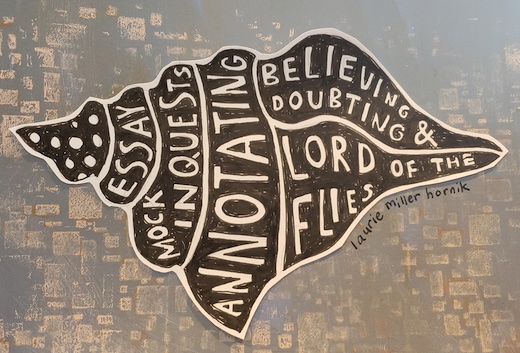Teaching Perspective with “Lord of the Flies”
By Laurie Miller Hornik
 Lord of the Flies by William Golding remains a riveting and relevant book to teach in middle school because of its themes of survival, power, and leadership. It is also an excellent vehicle for teaching students to appreciate multiple perspectives and be open to changing their own minds.
Lord of the Flies by William Golding remains a riveting and relevant book to teach in middle school because of its themes of survival, power, and leadership. It is also an excellent vehicle for teaching students to appreciate multiple perspectives and be open to changing their own minds.
The unit I teach to my seventh grade students, Believing and Doubting in Lord of the Flies, helps students practice these important skills throughout the reading of the book and the projects that come afterwards.
1. Reading the Book
Before teaching a book like Lord of the Flies, it’s important to have a clear focus. You can’t teach everything about this – or any – book; there isn’t time, and these are middle schoolers – not graduate students.
Our focus on considering multiple perspectives begins early in our reading. As soon as my students can tell all the characters apart, most of them see Ralph as the “protagonist” and Jack as the “antagonist.” This isn’t wrong. The text leads the reader to see the boys this way.

I introduce my students to a version of Peter Elbow’s The Believing Game.” Elbow created this exercise back in 1972 to help his graduate students consider an idea more fully before moving to criticize it. He had them spend significant time “believing” a thesis before moving on to “doubting” it.
“Aren’t believing and doubting the same as agreeing and disagreeing?” a student usually asks me. And while they are similar, the main difference – and it’s an important one – is that believing and doubting tend to evoke more empathy.
I ask my students: “Imagine someone who believes this statement. What reasons might they have?” While the focus is still on the ideas, it encourages the students to picture the ideas attached to a person who, in good faith, believes these ideas. And this, in turn, encourages the students who might not believe the statement to approach the ideas in good faith as well.
As we read Lord of the Flies, we practice believing and doubting with statements like these:
- Since he was voted leader, Ralph has a special responsibility to all the boys on the island.
- Jack would make a better leader than Ralph.
- Piggy would make the best leader of all the boys.
- There really is a beast on the island.
- Jack separating from the other boys caused their civilization to fall apart.
- Ralph should be held responsible for the disintegration of civilized society on the island.
- Jack should be held responsible for the disintegration of civilized society on the island.
- The ending of the book is a happy one.
2. Group Projects: Writing and Performing Inquests
Once students have read the entire book, we begin our Inquest Project, which is similar to a Mock Trial. I used to conduct a more traditional Mock Trial project: I would divide each class into four groups and we’d put Ralph and Jack on trial to determine whether either or both of them should be found guilty for the disintegration of civilized society on the island.
One team would be Ralph’s prosecutors, building a case for why he should be held responsible. A second team would be Ralph’s defense. The third and fourth teams would be Jack’s prosecution and defense. We’d hold two separate trials, one for each of the two characters. What happened, though, was that students cared so much about “winning” that it was hard for them to keep their minds open to change. So now we do Inquests instead, and here’s how:
I divide the class into pairs instead of teams. In each pair, one person plays a defendant (Ralph or Jack) and the other is the “Interrogator.” It is the job of the Interrogator and the character to show why this character both should and should not be held responsible for what happened on the island.
For the purpose of the Inquests – and the essays that will follow – we now add the terms “argument” and “counterargument” to our work, alongside believing and doubting. The position the pair of students “believes” becomes their argument, and they create a counterargument by considering what someone who doubts their argument might say.
We talk about why it is important to “steelman” instead of “strawman” the counterargument. I want them to have these concepts, although in general they naturally “steelman” the counterarguments because they’ve been practicing taking multiple perspectives throughout the unit.
Each pair writes a script of their interrogation using this structure: Opening Statement, Argument, Counterargument, Closing Statement. As an exemplar, I present them one I’ve written about Jack from “Jack and the Beanstalk” – yet another Jack who is either naughty or misunderstood or both. To differentiate and help focus the inquests, I assign each pair a defendant (either Jack or Ralph) and also a piece of physical evidence to incorporate into their Inquest – such as a conch shell, a piece of firewood, or Piggy’s glasses.
The pairs perform the Inquests for the class, often with some additional props and costume elements they bring in. This project is highly motivating and lots of fun. The partner work is done mostly in class, so I don’t feel the need to “grade” the work. Instead, it serves as a rehearsal for the essays students will write individually. In fact, the Inquest’s structure (Opening Statement, Argument, Counterargument, Closing Statement) closely aligns with the structure of the essay students will be writing afterwards.
While watching the pairs perform, students take a few notes on what really struck them – especially arguments and counterarguments that changed their mind, even just a little.
3. Individual Project: Writing Argument-Counterargument Essays
Each student now works individually to write a formal essay addressing the same question: “Choose either Ralph or Jack. Is this character responsible for the disintegration of civilized society on the island?” They use the same structure as the Inquest (Introduction, Argument, Counterargument, Conclusion) and learn how to use language appropriate for an essay rather than a trial or interrogation.
While novice essay writers often struggle to include enough textual evidence, my students already practiced incorporating evidence during the Inquest, and they find it natural to now use it in their essays.
All the Inquest scripts are shared with the whole class, so students can go back and find something they admired in an inquest script that they want to adapt for their essay. They practice using each other as resources and writing acknowledgments to thank them. This essay is a major “graded” writing assignment. (For information about how I grade, see Give Students Writing Feedback That Works.)
4. Extending the Work Outside the Book
Finally, we consider where else we might use the “believing” and “doubting” approach. Which questions in our communities and in the larger world would benefit from a “believing” and “doubting” approach? And which questions wouldn’t? In our current polarized climate, we can’t take on heated political issues during English class, but I give students time to freewrite privately about situations in which they might use these approaches outside of class with their family and friends.
Laurie Miller Hornik is a K-8 educator with over 30 years of experience. Currently, she teaches seventh grade English at the Ethical Culture Fieldston School in NYC. Laurie is the author of two middle-grade humorous novels, The Secrets of Ms. Snickle’s Class (Clarion, 2001) and Zoo School (Clarion, 2004). She writes a weekly Substack of humorous essays called Sometimes Silly, Sometimes Ridiculous and creates mixed media collages, which she shows and sells locally and on Etsy.
Feature image: William Golding website, “Piggy’s Glasses.”
Conch image: Laurie Miller Hornik






























